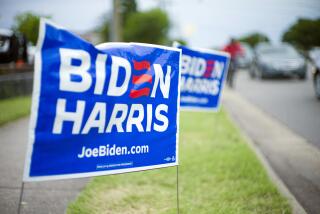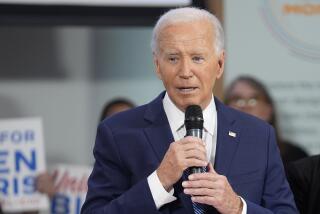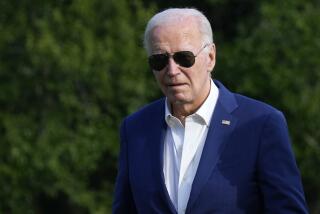Column: Stop thinking of Bernie Sanders as a gadfly. He’s the front-runner
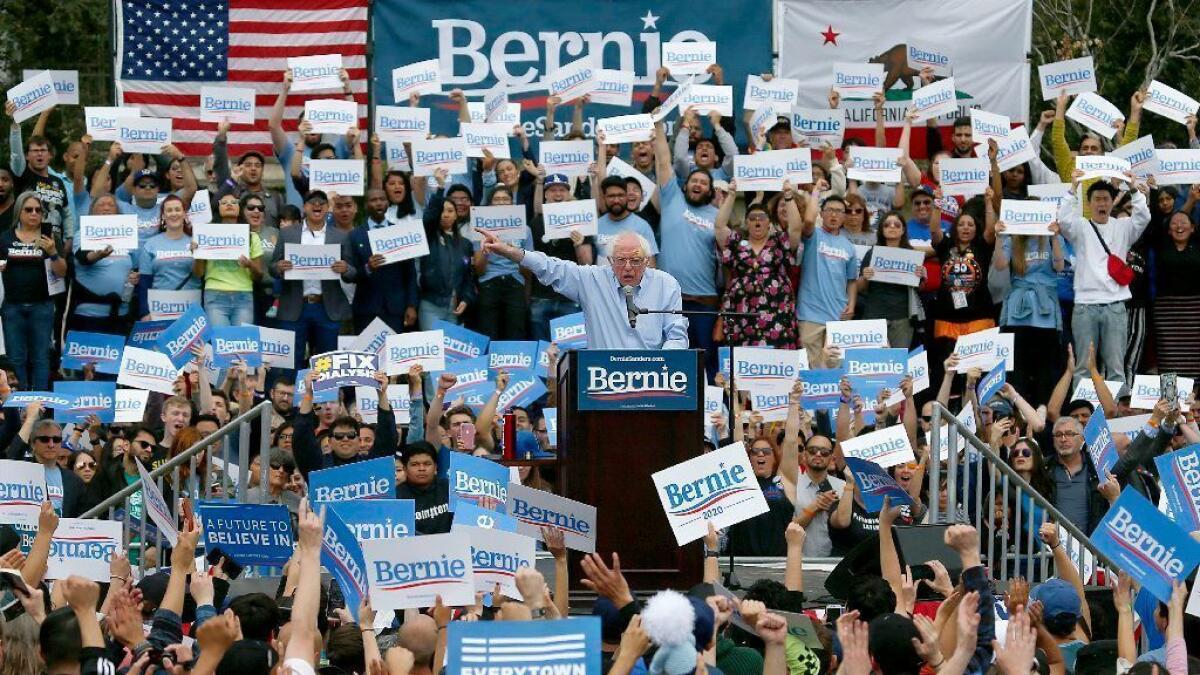
- Share via
Reporting from Washington — In case you missed it, Bernie Sanders is now, for all practical purposes, the front-runner in the race for the Democratic presidential nomination.
The Vermont socialist pulled in $18 million in the first three months of 2019, most of it from small donors. His nearest rival, Kamala Harris, collected $12 million, with others far behind.
Sanders’ campaign is off to a strong start by other measures, too. He says he has signed up more than 1 million volunteers for (in his words) “a grassroots effort the likes of which has never been seen.” He’s staged rallies from coast to coast, drawing crowds of 10,000 or more.
In national polls, he runs second to the most popular undeclared candidate, Joe Biden. But surveys show Sanders ahead of Biden in Iowa and tied for first in New Hampshire, the two states that hold the earliest contests.
There are caveats, of course. The campaign is still in its early days. More candidates, including Biden, are expected to get in.
Most important, at this point national polls measure little more than name recognition, and state-level polls in Iowa and New Hampshire are unreliable guides to voter behavior eight months from now.
Still, Democratic strategists are beginning to consider a prospect once dismissed as unlikely: Sanders — a candidate the establishment saw as a gadfly in 2016 — could get the nomination at the Democratic National Convention in Milwaukee.
“Bernie could certainly win,” said Tad Devine, who was Sanders’ chief strategist in 2016 but isn’t working for him this time. (They had a falling-out at the end of the last campaign.) “His base of support is solid. He’s raising substantial resources.”
Sanders’ chances look better this time for several reasons.
The biggest difference between 2016 and 2020 is that this time will likely see more than a dozen candidates vying for votes in Iowa and New Hampshire — which means a candidate could win there with no more than 30% of the vote.
There’s precedent for that. Jimmy Carter won Iowa with only 28% in 1976 and went on to win the nomination and the presidency. Twenty years later, Bob Dole won Iowa with 26% and won the Republican nomination.
If Sanders can win both Iowa and New Hampshire, even with narrow pluralities, he’ll be the odds-on favorite for the Democratic nomination. Since 1972, five of six candidates who won both states in contested races went on to become their party’s nominee.
The reason? Winning attracts more supporters, a bandwagon effect. To stop Sanders at that point, another candidate would need to win several other contests quickly to become a clear alternative. Harris could do that by winning in South Carolina and California, which has moved its primary date to March 3.
A second factor that helps Sanders: The Democratic Party no longer allows “superdelegates,” hundreds of elected officials and other party elders, to vote on the first ballot at the convention.
That would make it harder for the party’s establishment (or what remains of it) to block a candidate who arrived with a majority or even a plurality of delegates.
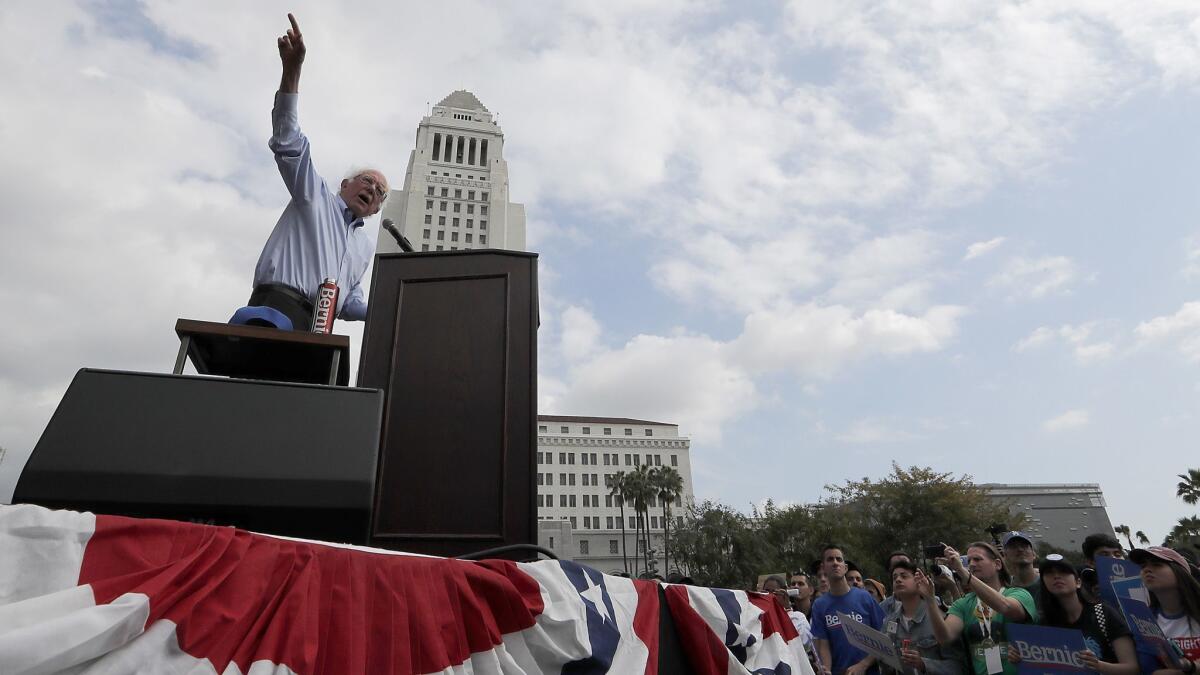
Sanders addresses a campaign rally in Grand Park.
A third factor is experience: candidates often perform better in a second presidential campaign than their first.
“When Bernie ran last time, he started as a message candidate. It was mostly about raising progressive issues, not, ‘I’m going to be president of the United States,’” said liberal radio host Bill Press, who hosted some of Sanders’ 2016 planning sessions around his kitchen table. “This time he’s after the nomination from Day One. That’s a big difference.”
One factor that hasn’t changed: Sanders’ left-of-center message.
“I don’t think he’s evolved in the last 40 years,” Press said. “That’s part of his strength. What you see is what you get.”
That may also be his biggest problem.
Sanders is the most uncompromisingly leftist candidate in the race, hands-down. His version of “Medicare for all” is a federally run single-payer health insurance plan with virtually no role for private insurers.
He still advocates free tuition at every public university in the country, a policy some Democrats criticize as a subsidy for the upper middle class. He still demands wholesale redistribution of income and wealth from “millionaires and billionaires.”
Other Democrats worry that Sanders would be a disaster in the fall election. They fear his unapologetic advocacy for “democratic socialism” will alienate moderates in a country where polls show “socialism” is a dirty word. (That’s one reason President Trump talks about it so often.)
“A Sanders nomination would, I fear, deliver the country to Trump,” progressive writer Eric Alterman, who says he voted for Sanders in 2016, wrote in the Nation. “Democrats cannot afford to bet America’s future on an invisible revolution.”
Maybe. One lesson we should have learned from 2016 is that in fractured times, implausible outcomes are possible. Don’t count Sanders out.
More to Read
Get the L.A. Times Politics newsletter
Deeply reported insights into legislation, politics and policy from Sacramento, Washington and beyond. In your inbox twice per week.
You may occasionally receive promotional content from the Los Angeles Times.
